The Yvonne and Gabriel Weisberg Collection
- Tom Rassieur, John E. Andrus III Curator of Prints and Drawings, Minneapolis Institute of Art
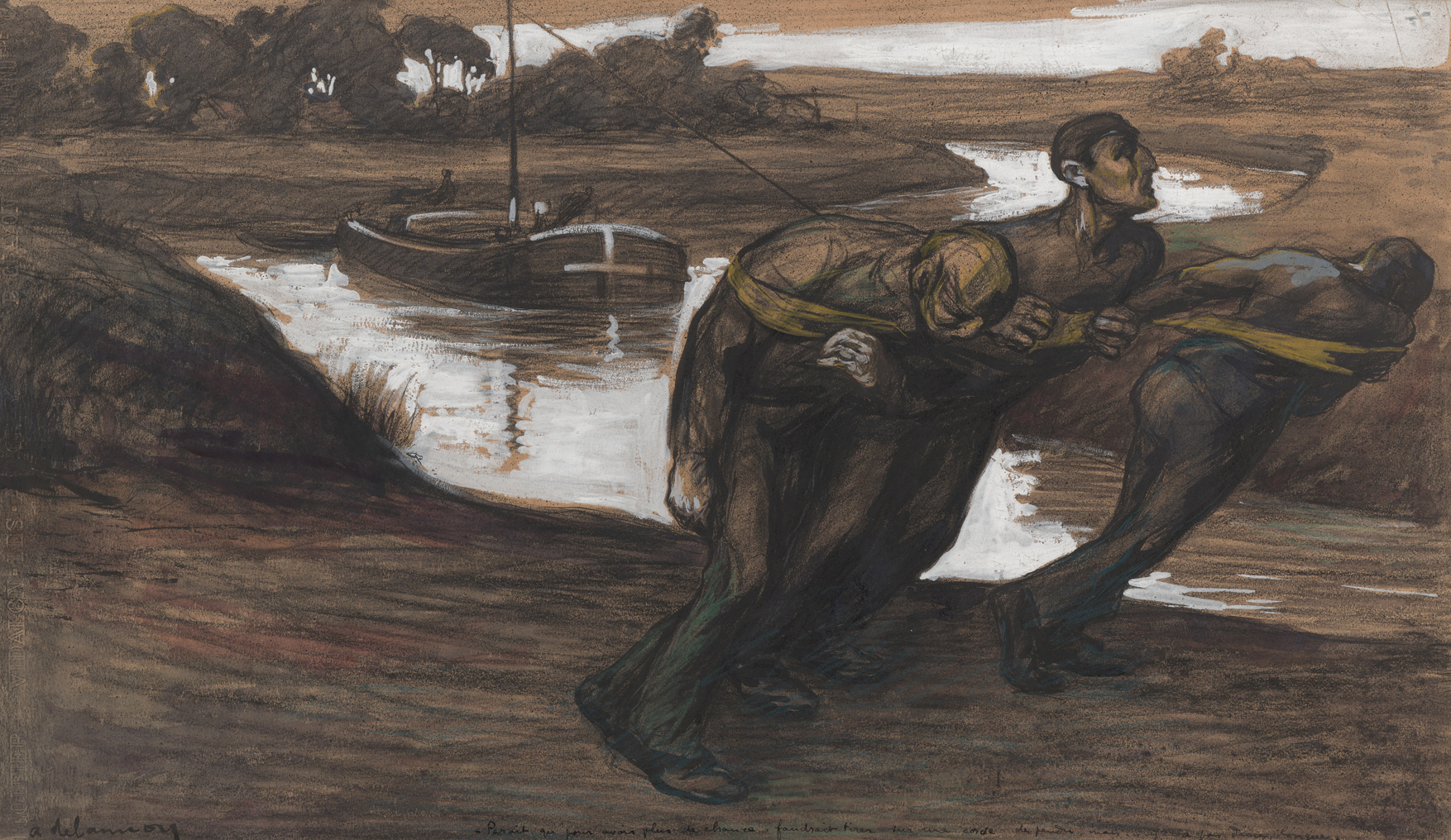
Yvonne and Gabriel Weisberg have been exploring neglected chapters of nineteenth-century art for more than fifty years. They have cast new light on forgotten or little-known artists by teasing stories out of dusty archives, visiting out-of-the-way towns, knocking on doors, and comparing notes with fellow enthusiasts. They have shared their findings in countless publications, lectures, and exhibitions. And because their interests lie with those overlooked talents who never gained the celebrity of, say, Gustave Courbet or Edgar Degas, the Weisbergs were able to purchase works of art as they went along. Today their collection, numbering more than 200 drawings, watercolors, pastels, and small paintings by more than 100 different artists, is a testament to their mission as educators and researchers. They have shared these works through loans and full-scale exhibitions—and most generously through the years-long project of giving their collection piece by piece to the Minneapolis Institute of Art (Mia), until the whole collection enters Mia after their death.
Realism in the Nineteenth Century
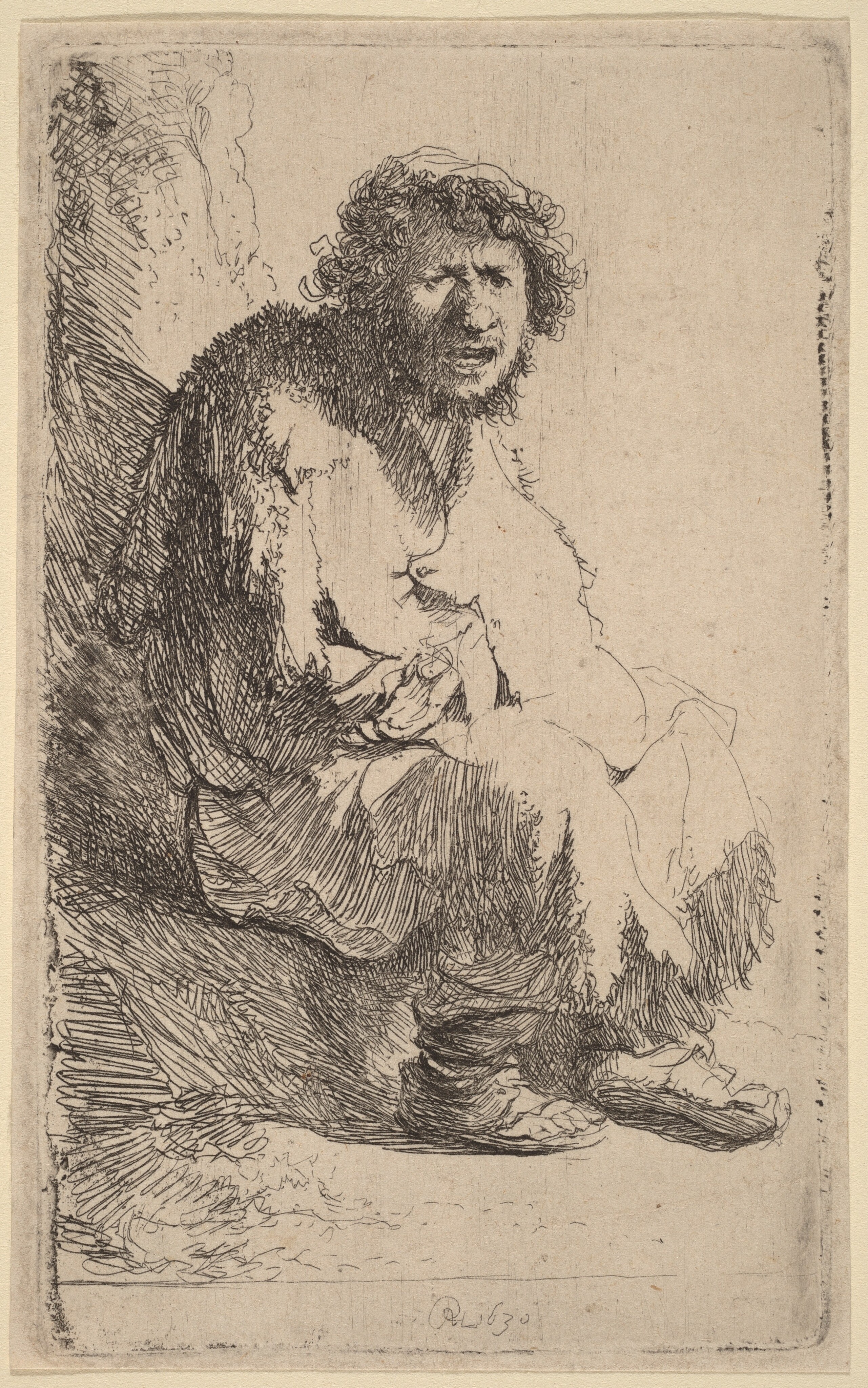
The Weisberg Collection covers a century-long swath of French and Belgian art, beginning in 1830. At its core lies Realism, a cornerstone of the Weisbergs’ scholarly reputation. Realists turned away from the mythology and heroic themes that dominated nineteenth-century academic art. They found such art overblown and false: images were being created based on subjects the artist had never seen or met. Instead of focusing on historic figures and their military, political, or biblical exploits, realists looked to people they saw in their daily life: farmworkers, artisans, laborers, vagabonds, neighbors, children, and people who were elderly or without jobs or homes. Realism flowered at a time when industrialization was bringing rapid change to France and Belgium. Realists depicted weavers whose handmade wooden looms were no match for machines powered by water and steam. They drew anonymous miners who dug the coal that powered these machines. They portrayed young women trapped in servitude and women making butter. They bore witness to community ceremonies that sought God’s blessing through the intervention of saints. They documented people hard at work and others who had no work—people whose lives could be buffeted by the decisions of others. In short, Realism was art with a social mission.
To escape the academic trends of the nineteenth century, realists looked to the art of the past. They appreciated the moody grittiness of seventeenth-century art, the warts-and-all approach of artists such as Rembrandt, Velázquez, and the Le Nain brothers (figs. 2–4).
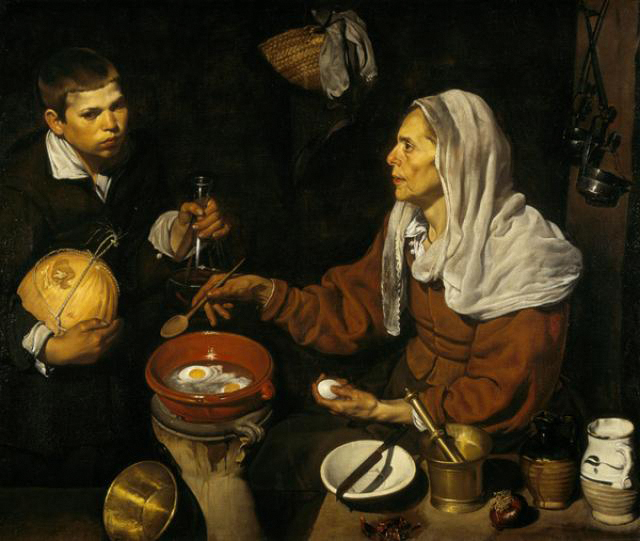
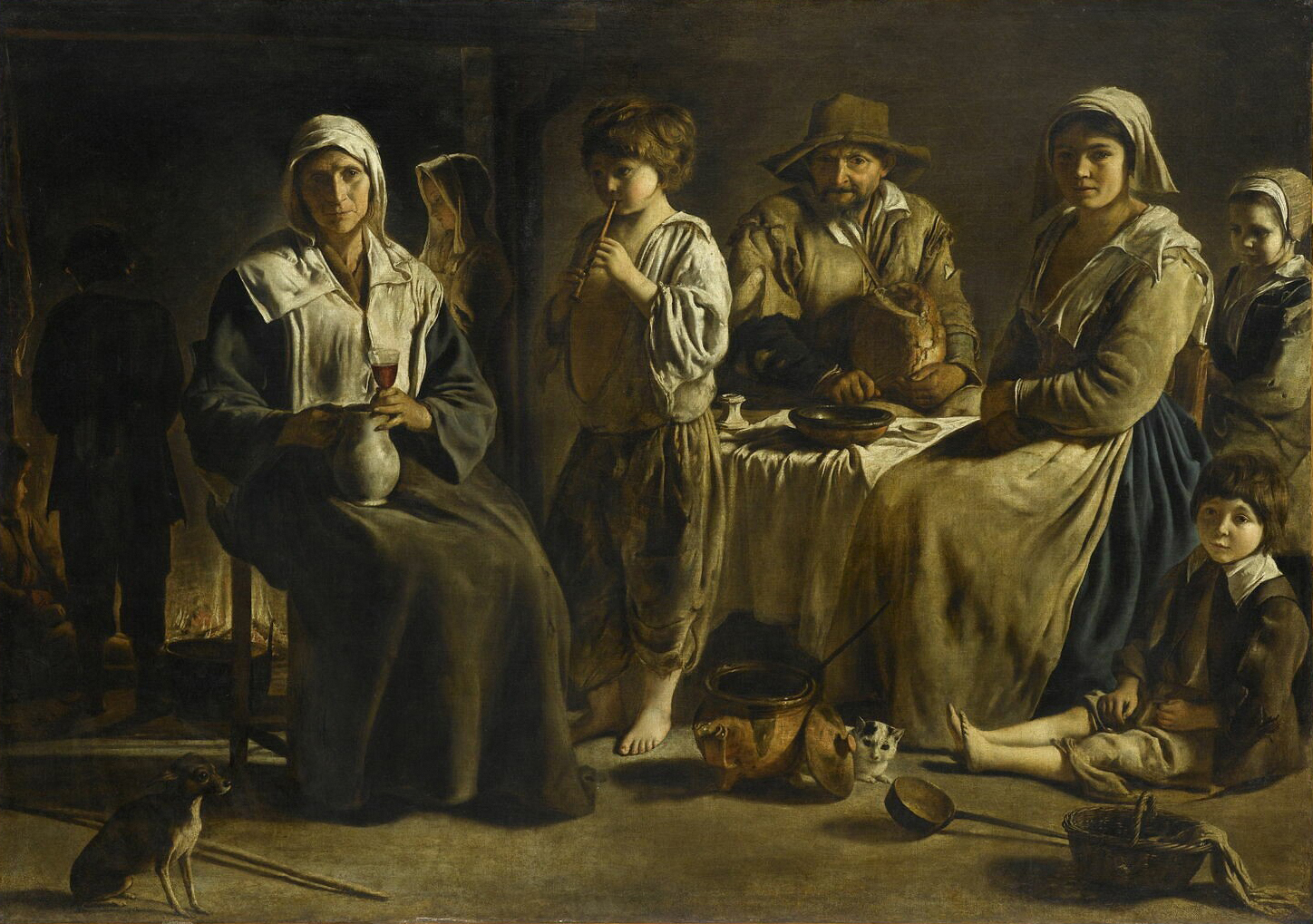
Realism was a recognized movement by the late 1840s, but as the Weisberg Collection demonstrates, the tendency started earlier. Included here is a roadside study of a resolute woman with a child drawn by Gabriel Alexandre Decamps in 1825 (fig. 5) and an encounter between two men drawn by Philippe Auguste Jeanron in the 1830s (cat. no. 91).
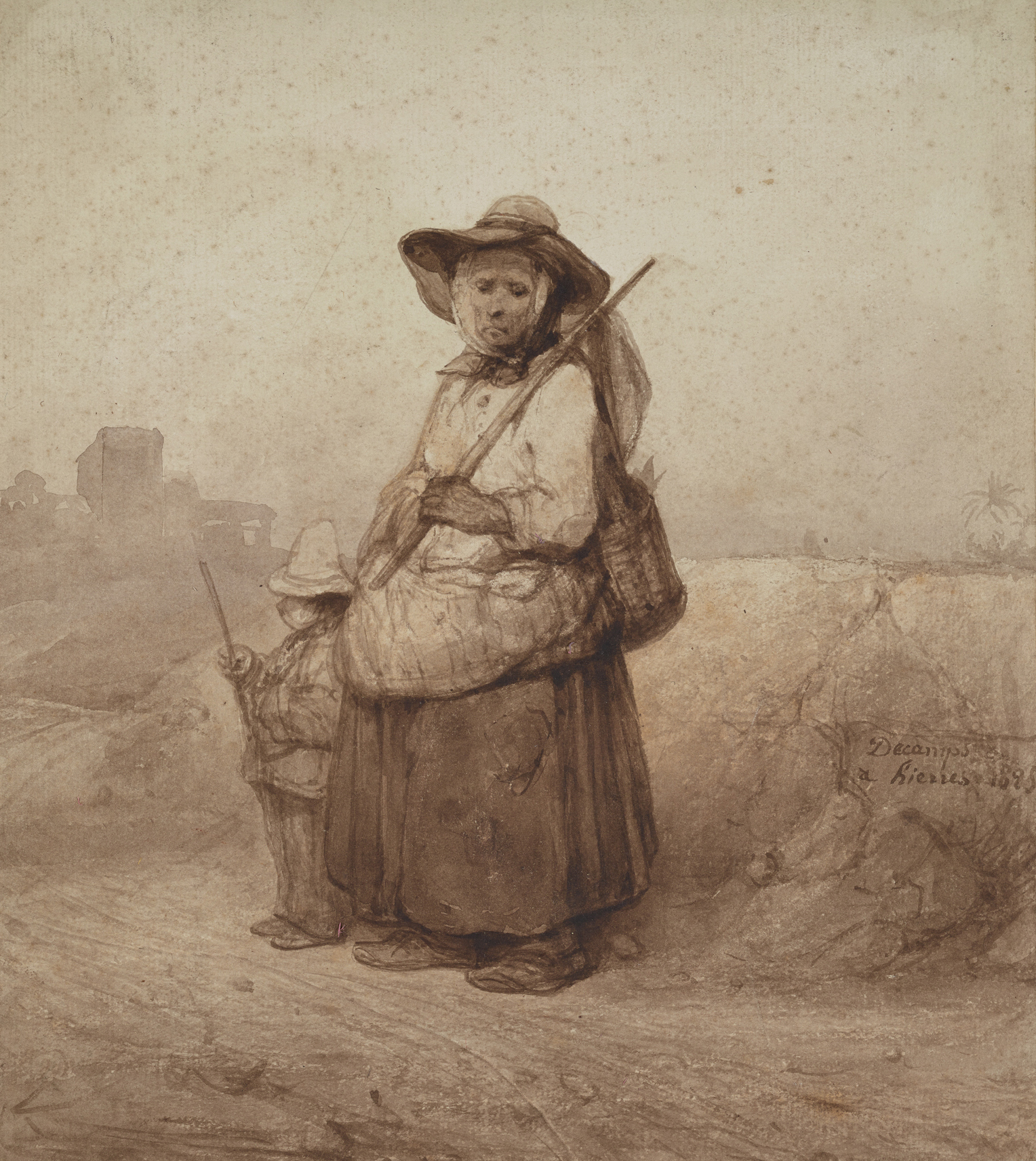
Both works show an early focus on the lives of the underclasses without sugarcoating them, as Romantic artists of the time often did. Realism continued into the 1900s, as we can see from Charles Maurin’s Mother Combing Her Daughter’s Hair from about 1905 (fig. 6). It shows a small moment of domestic intimacy that again has parallels in seventeenth-century Dutch artworks (fig. 7) yet eschews their moralizing undercurrents.
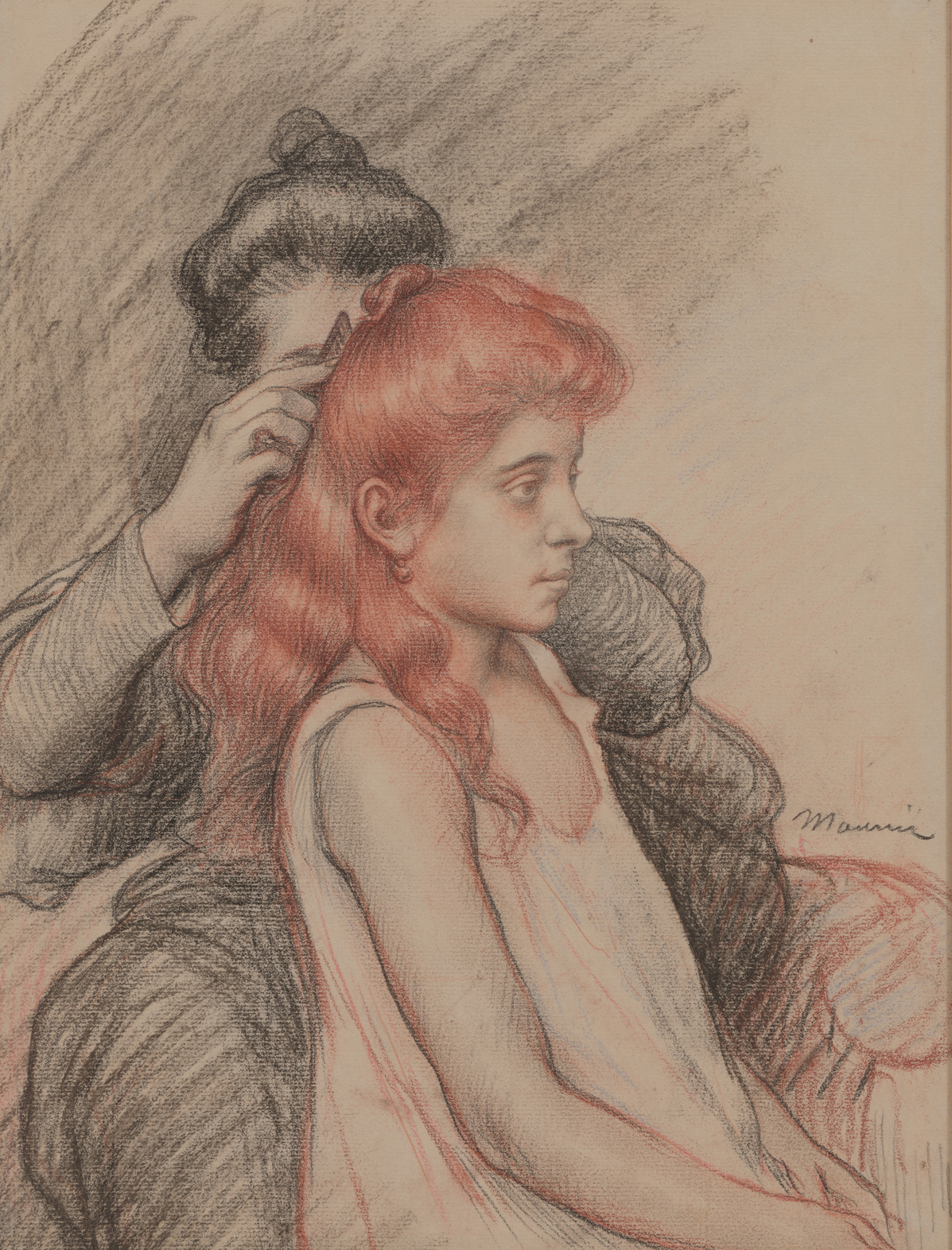
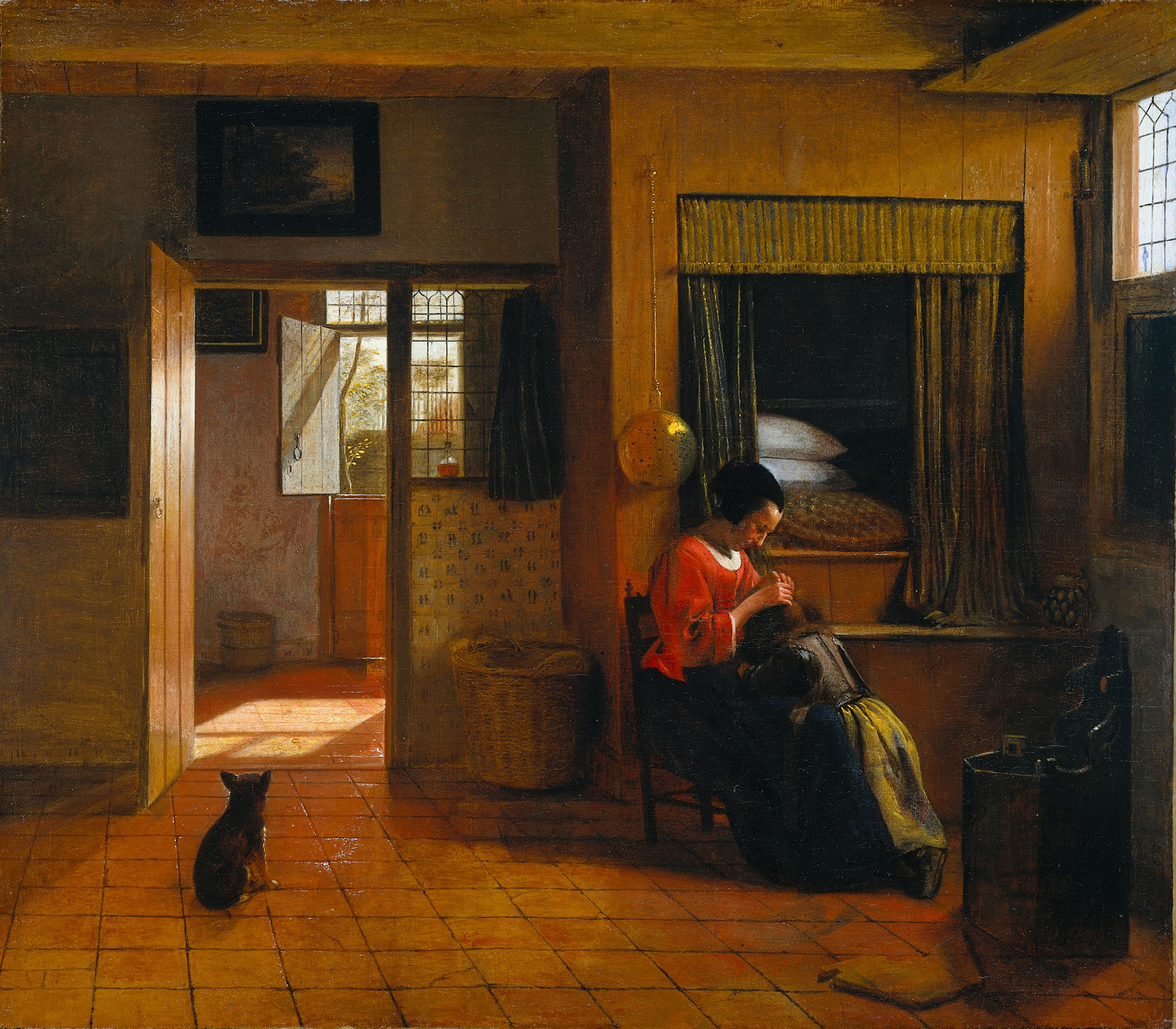
The first major exponent of Realism to enter the collection is the self-taught François Bonvin. Gabe Weisberg authored the catalogue raisonné on Bonvin and is a highly respected authority on him.1 Bonvin worked side by side with his friend Courbet to advance the tenets of Realism. In the early days, Bonvin was actually better known than Courbet. The artists shared an interest in Dutch and Spanish art, with its attention to everyday life and its often-muted palette. The Weisberg Collection contains seven works by Bonvin, a painting and six drawings. One immediately sees the taste for Rembrandt in the self-portrait showing Bonvin wearing his Paris policeman’s hat, an accoutrement of his livelihood before he was able to support himself as an artist (fig. 8).
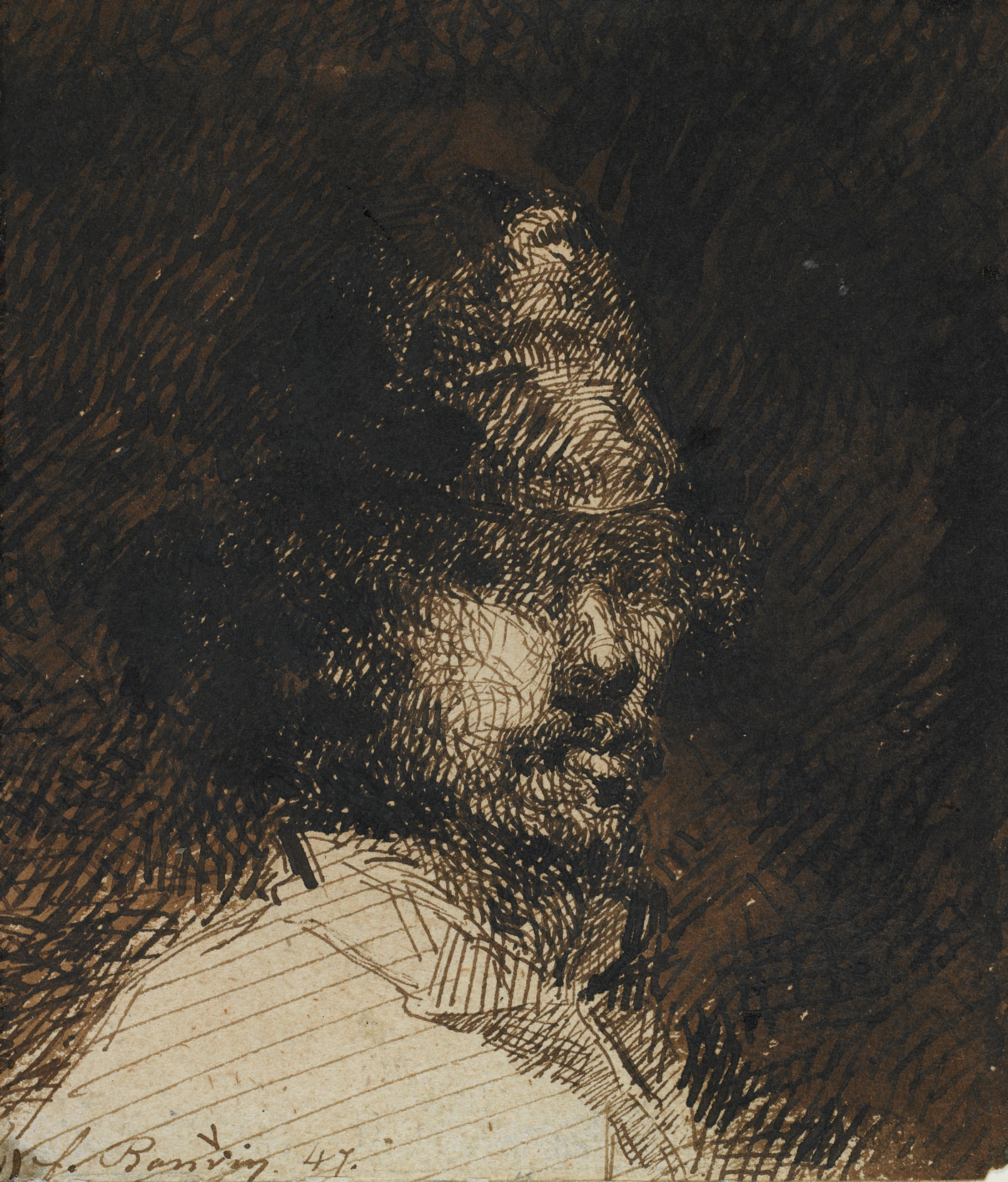
The tangle of pen lines and brushed-on washes produces a strong chiaroscuro effect in which the artist emerges from the shadows to observe us as we observe him. The technique, stagecraft, and psychological engagement reveal him to have been a great student of the master even at two centuries’ remove. Bonvin’s drawings of a ragpicker and of an elderly woman feature the dignified treatment that he offered subjects well outside the bourgeois and aristocratic strata (cat. no. 28, cat. no. 30). Carefully studying his sitters, he presented them in a straightforward manner, without pity, judgment, or aggrandizement. The result offers the viewer a shared experience of humanity. An early Bonvin drawing of monks in a monastery (fig. 9) was made in 1842, at about the time he took up drawing, to pass the time during his convalescence in a hospital. It predates his interest in Realism and shows his familiarity with the Romantic artist François-Marius Granet, who specialized in dramatically lit interiors, such as Mia’s The Choir in the Capuchin Church on the Piazza Barberini (c. 1815–30; fig. 10).
With their dedication to and deep knowledge of Bonvin’s art, the Weisbergs have assembled an array of objects that offers great insight into the artist’s career and interests.
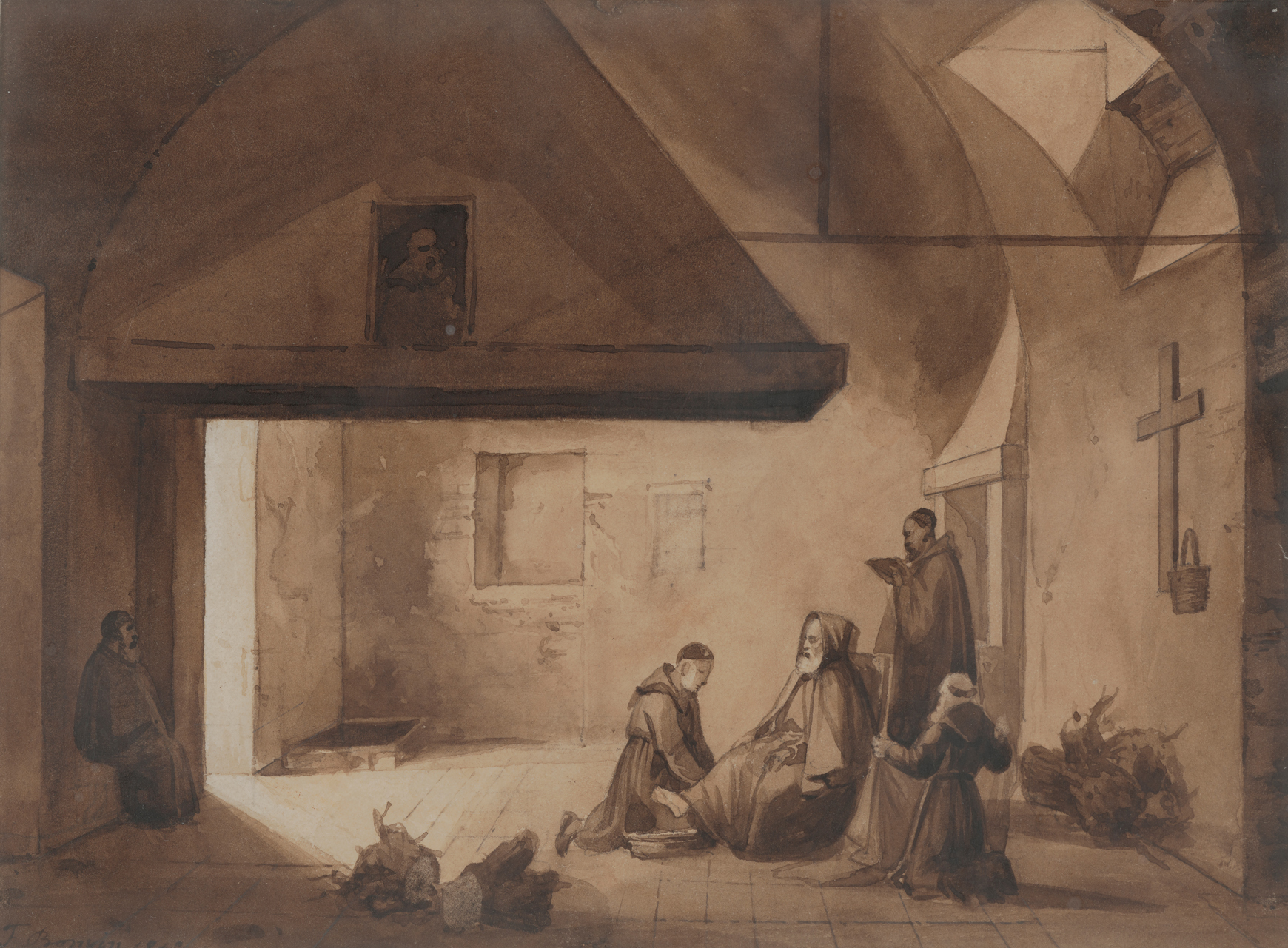

Bonvin is not the only artist that the Weisbergs have collected in depth. An outstanding example is Charles Milcendeau, another artist who carried the realist tradition into the twentieth century. Milcendeau was from the Vendée in western France. Like many realists, he spent much—but by no means all—of his energy recording his local community. To date, the Weisbergs have assembled an impressive fourteen drawings and watercolors (cat. nos. 129–142). These encompass intimate portraits, rural domestic scenes, the faithful praying, people drinking, a blind man eating, and even denizens of the streets of Seville, Spain—a place the artist loved so much that he painted his doorway to resemble a Moorish gateway, as seen in the watercolor he made of his modest home (cat. no. 139). Occasionally, Milcendeau also showed an awareness of seventeenth-century Dutch art (figs. 11–12).
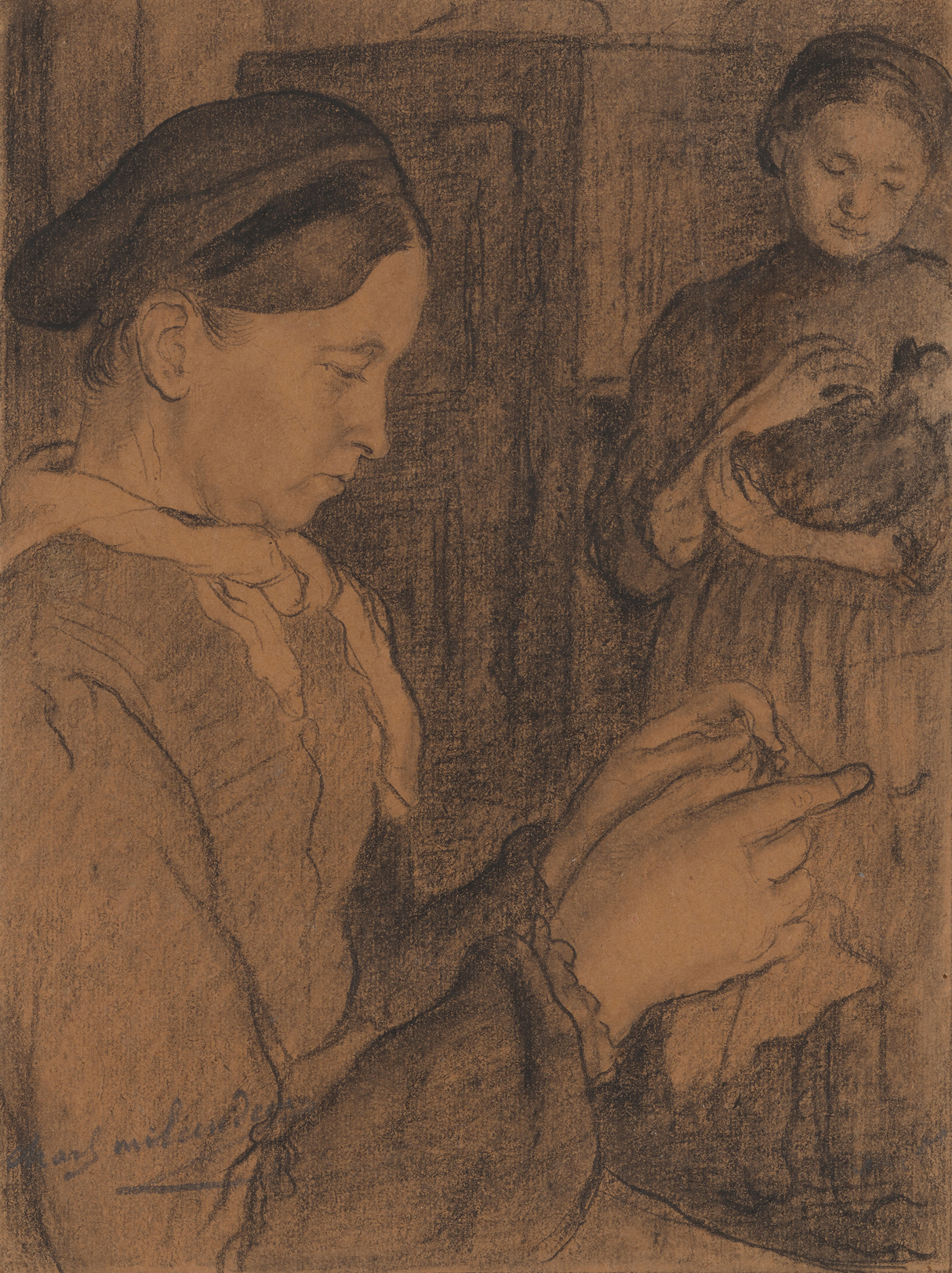
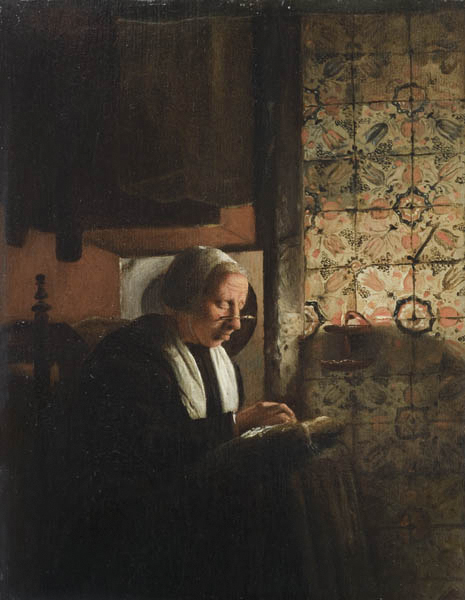
The Weisbergs are not shy about expressing their preference for the artist’s drawings over his paintings. When at his best, Milcendeau has the power to move the viewer, whether through the fading light on a man relaxing after a day’s work (cat. no. 137) or the deep concern marking the faces of women beneath a stormy sky awaiting the return of the village fishermen (cat. no. 133). With their gift to Mia, the Weisbergs are entrusting the museum with the best representation in America of this underappreciated artist.
Though they often are no longer household names, many of the artists presented here were consummate draftsmen. One is the prolific Léon-Augustin Lhermitte. The Weisbergs’ four splendid drawings include a complex and nuanced study of a weaver’s workshop (fig. 13), a record of a village ceremony rooted in the medieval past, and an unflinching portrait of a peasant woman—all mainstream realist subjects (cat. nos. 115–117).
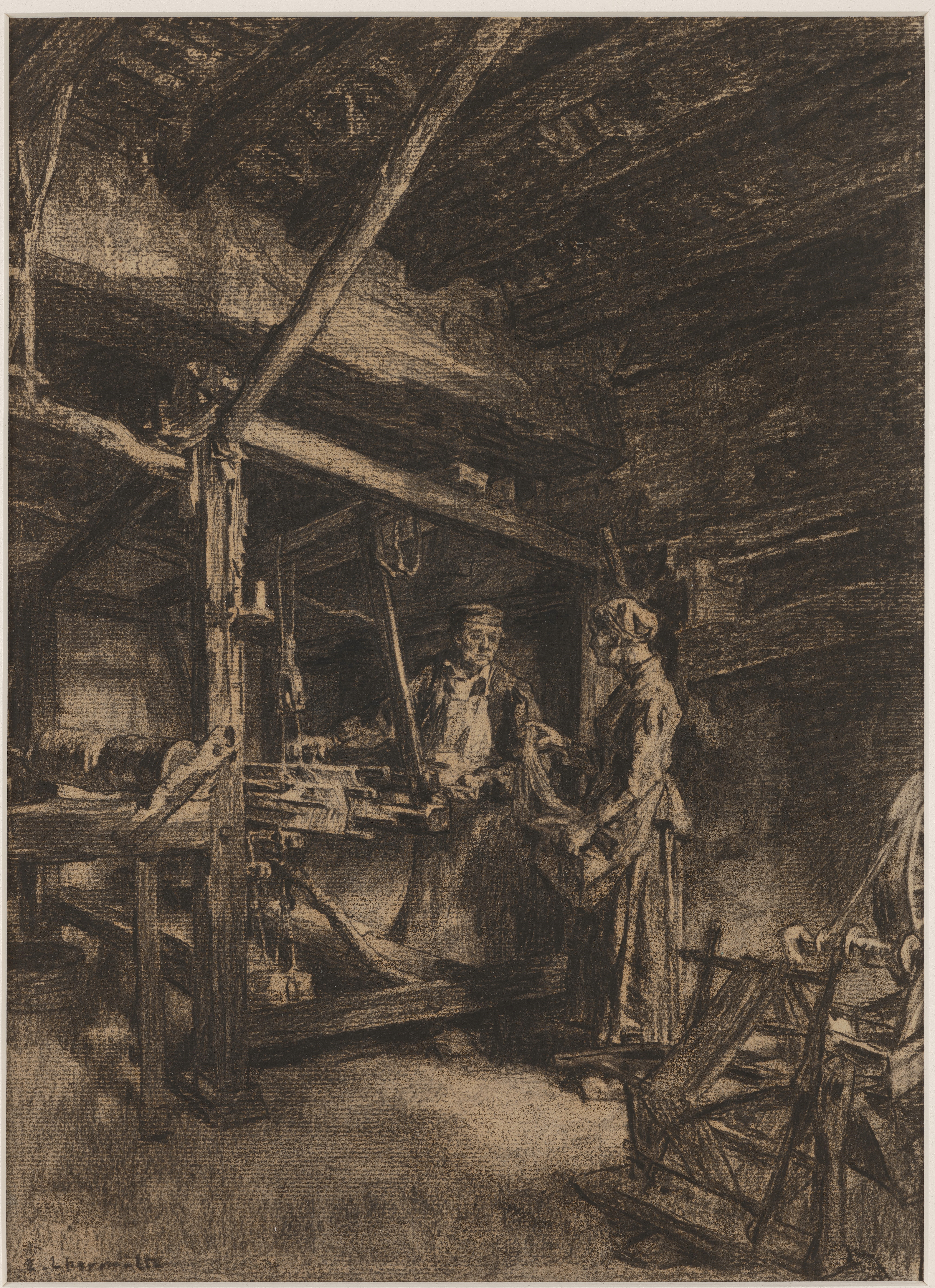
The weaver’s loom would have already appeared quaint and outmoded when Lhermitte drew it in the 1880s. The guild of bowmen pictured in the Feast of the Company of Archers, from 1872, would have seemed archaic given that by then machine guns capable of firing hundreds of rounds per minute were in use. Yet, many people still relied on old technology for their livelihoods and on ancient organizations and customs to help maintain deep communal bonds. The academic male nude by Lhermitte, albeit unexpected, suggests the disciplined study behind his accomplishments (cat. no. 114).
Even a casual exploration of the Weisberg Collection reveals a number of common themes, whether subject, medium, or function. Such connections throw aspects of artistic practice and personality into high relief, thus heightening our perception of each work. For example, the late nineteenth century was a golden age for charcoal, as four masterful examples attest. Two are by Maxime Lalanne (figs. 14–15, cat. nos. 100–101), whose 1869 handbook on charcoal drawing was the first ever published. One drawing shows him producing a work of self-conscious perfection; the other shows him working on a smaller, more personal image.
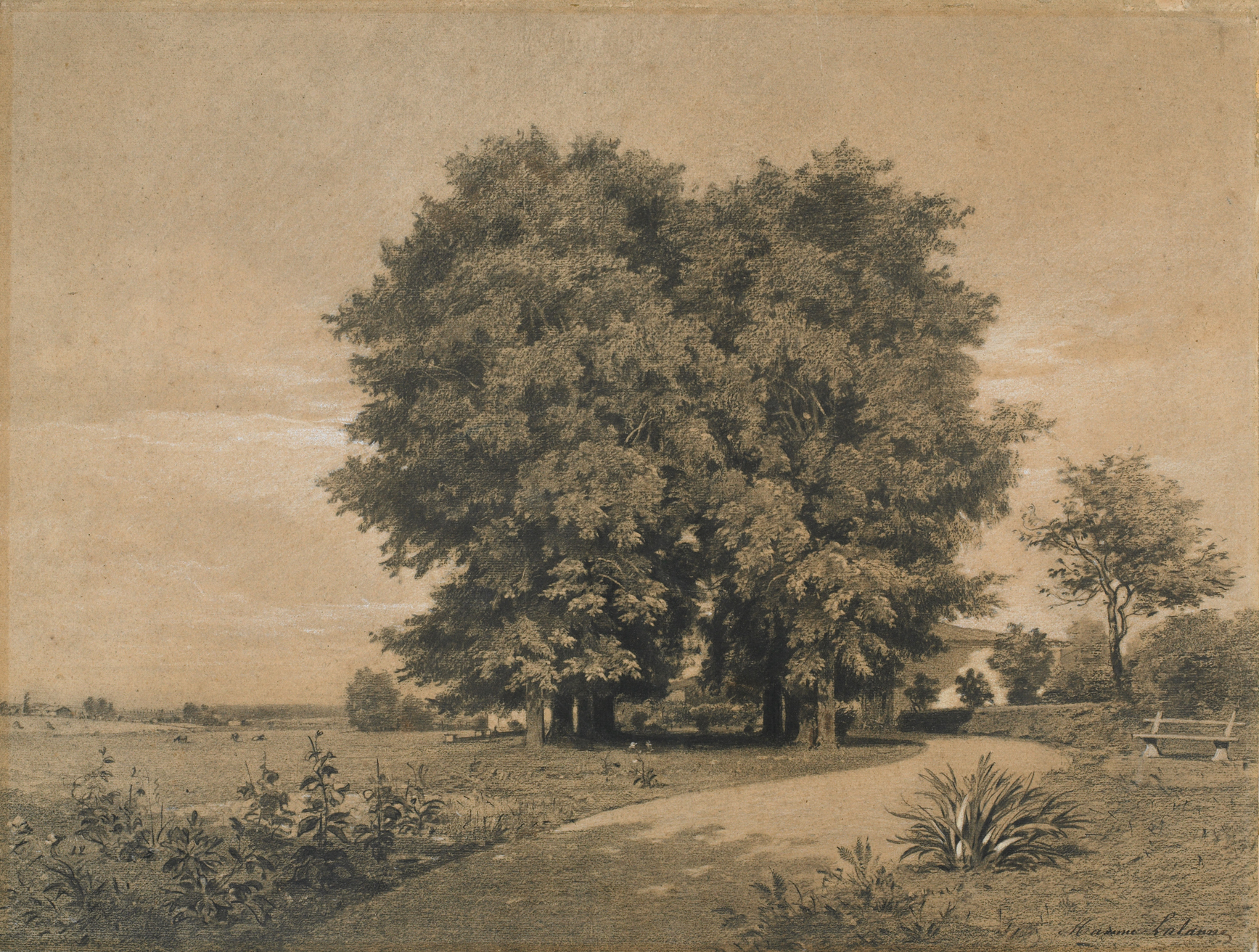
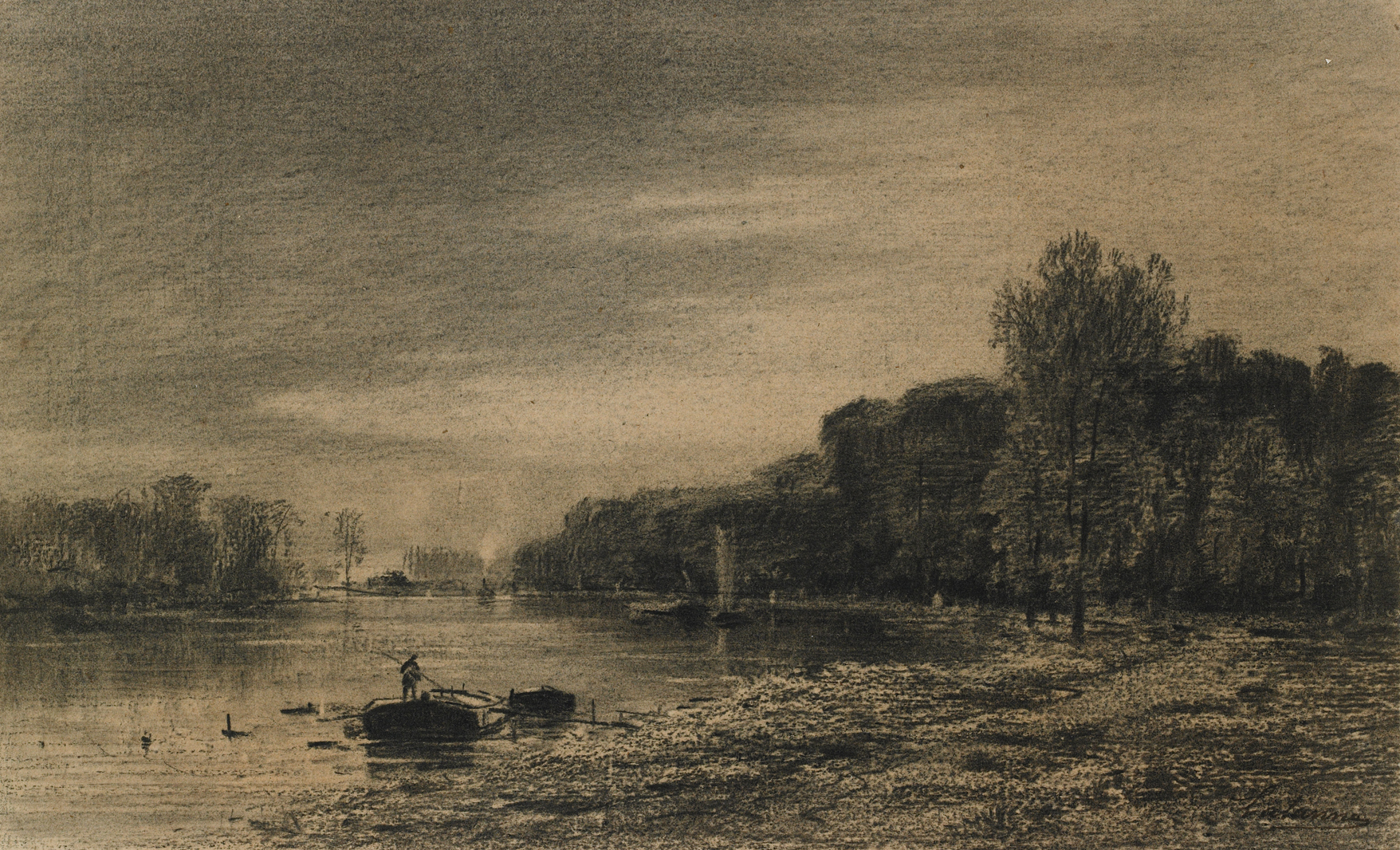
The two other charcoals are by the accomplished Adolphe Appian (cat. nos. 6–7). In them we can see a different type of contrast. One is a brilliant, evocative, highly finished study of a boy watering his horse in the shallows of a river; the other is looser and slightly wild—perhaps a reflection of the artist testing new stylistic directions.
Many realists represented here share a tendency toward subdued color and somber mood. These works ask much of the viewer. They are not glitzy entertainment but more like good, serious reads. Their age and foreign genesis add to the challenge. Yet, if we allow ourselves time and engage openheartedly, we quickly see the astounding skill that went into making them. We may also come to see the parallels with our own time and place. How many people are just scraping by today? How many rural towns are withering in the face of technological change and the rise of a new gilded age? How many people are turning to faith amid challenges to their traditional way of life? What city doesn’t present a hard grind for many of its inhabitants? Who doesn’t enjoy the gleam in the eye of youth and wonder about the depredations of aging? These works treat themes that can draw many of us together and may help us understand the actions of those whose circumstances may be unlike our own.
Functions of Drawings and Small Paintings
Drawings and small paintings can serve as visual aids to memory, as repositories of ideas for future use, or as preparatory designs for more finished works of art. A drawing can also be a finished work, made to sell or present as a gift. The Weisberg Collection contains examples of all of these, and sometimes a single drawing falls into several categories—say, a preparatory work going to someone who appreciates the rougher character or the smaller scale of such an object.

Sketches tend to have a remarkable vitality. Often they show the artist on the hunt, trying to capture the action of a fleeting moment. Jeanron witnessed the July Revolution of 1830 and saw rioters scrambling onto a commandeered carriage (cat. no. 90). Jeanron’s pen marks show that his hand raced to keep pace as events unfolded. On a single sheet of paper, he caught two moments of the carriage incident as well as the movement of other combatants. Charles François Eustache’s studies of a man working at a furnace (cat. no. 73) suggest that this artist could take his time. He noted his subjects in various attitudes, both toil and rest. He drew multiple versions of poses, making adjustments to heighten the sense of exertion. A series of small drawings by Théodule Ribot, likely extracted from a sketchbook, records quiet moments at home or in his studio—different poses of a left hand (his own?) and a woman lost in concentration as she writes or draws (cat. nos. 164–165). Though the latter is a seeming trifle, Ribot signed it, suggesting his awareness that his little sketch would be of interest to others. One of the most amusing objects in the collection is the logo of the newspaper Paris (fig. 16). Amid those big black letters Ribot sketched caricatured heads, undoubtedly smiling to himself as he looked around a sidewalk café in search of his quarry.
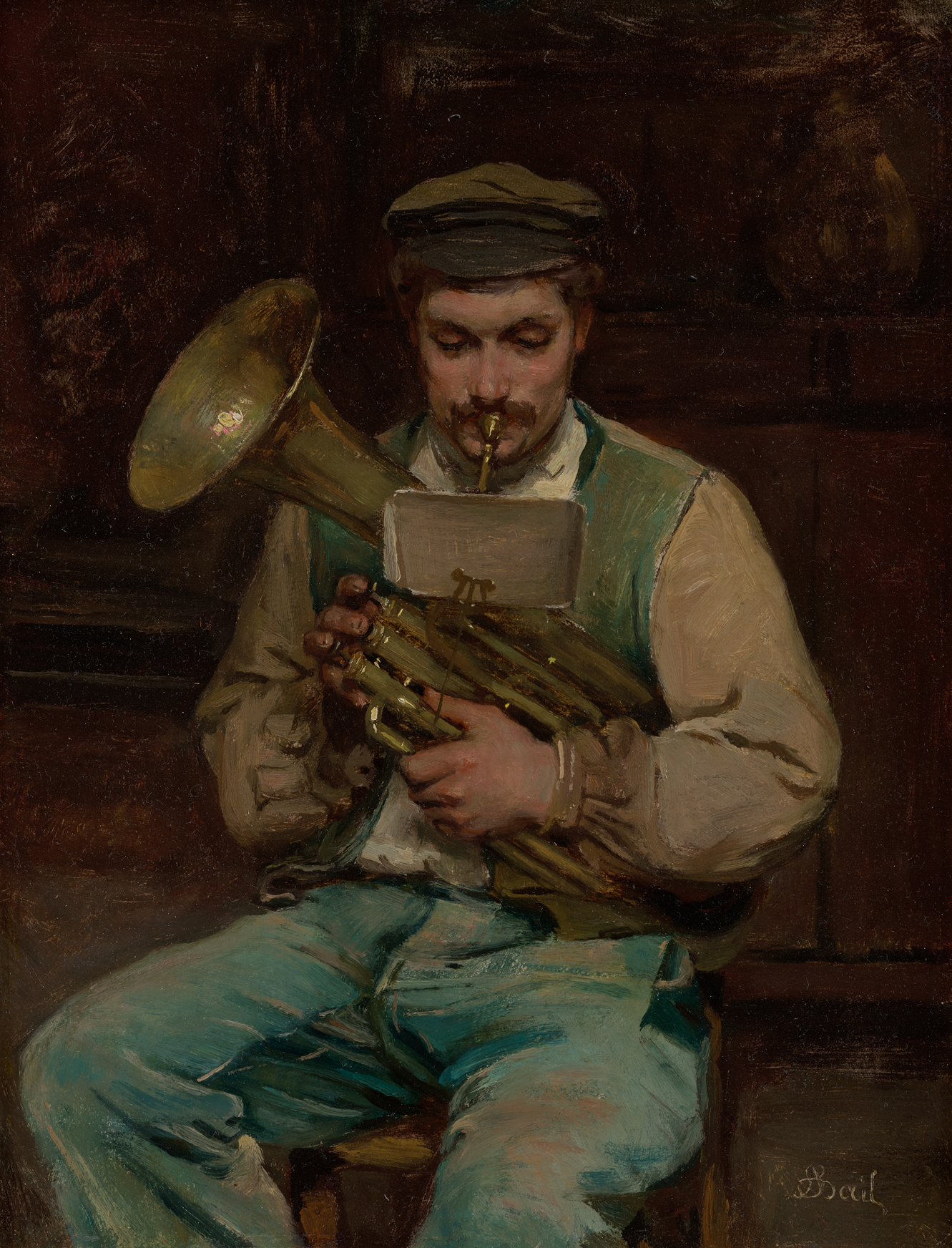
Drawings made in preparation for a finished work are a strong suit of the collection. These are works that usually lead to the production of bigger, grander paintings or luxury goods. One of the most significant is Jules Breton’s oil sketch of a young woman (cat. no. 40). She became a central figure in The Gleaners of Courrières (1854), a major painting that deals with a then-debated political issue having to do with the rights of agricultural workers to retrieve grain left behind in fields after a harvest. The painting would launch Breton’s career and establish gleaning as a new subject of interest among realists, including Jean-François Millet. While vacationing near the forest of Fontainebleau, Antoine-Jean Bail painted a local playing a cornet (fig. 17), an image he later turned into a full-length painting for public display.
Other preliminary drawings are compositional sketches, ideas for the overall design of the final work. Two strong examples are Claude Joseph Bail’s depiction of youthful kitchen workers and their gleaming copper pots and Eugène Laermans’s idea for villagers gathered in prayer at the water’s edge (cat. no. 14, cat. no. 99). The former composition required just a few refinements as it was translated into paint. The Laermans image, however, underwent many changes as the artist’s thoughts evolved.
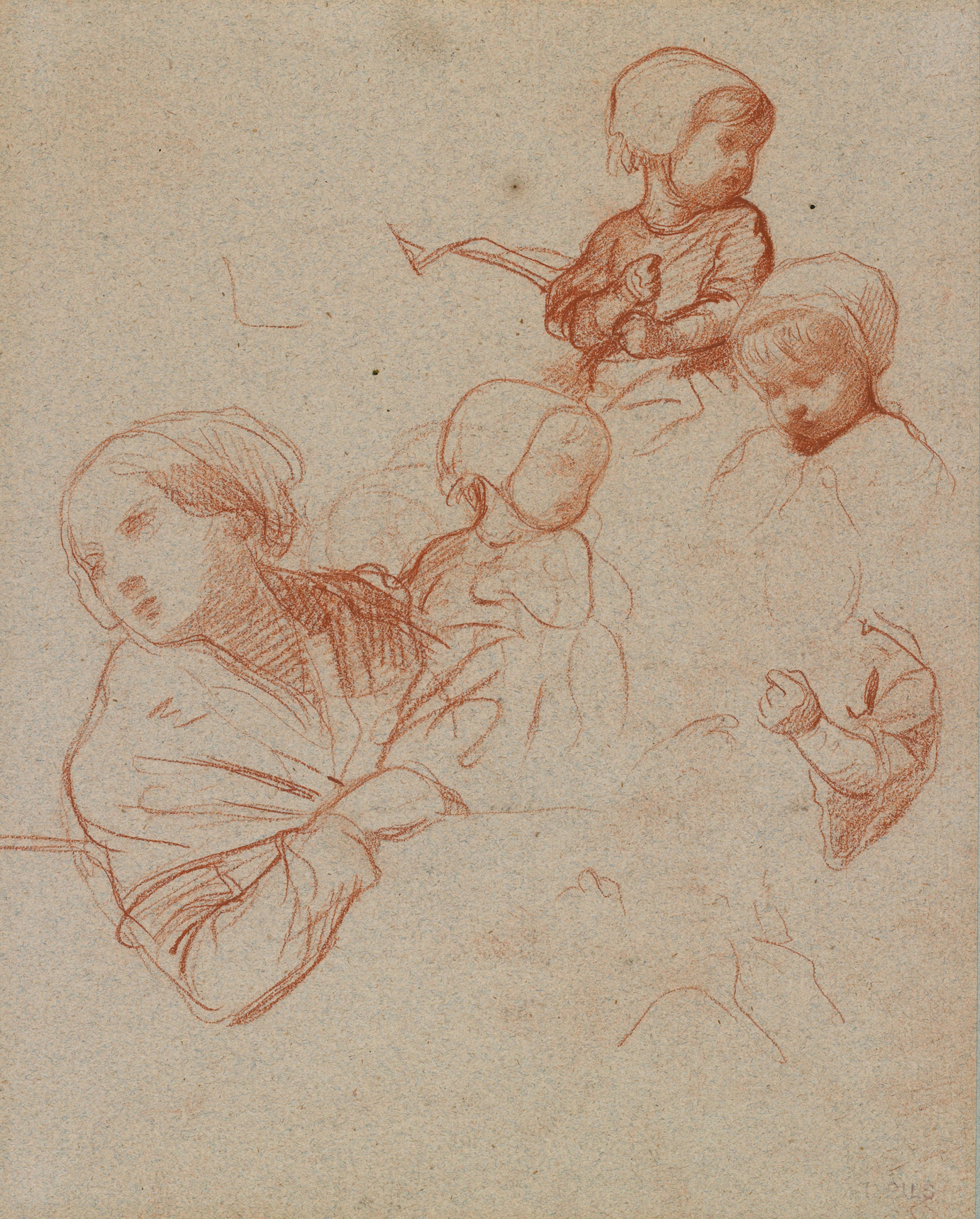
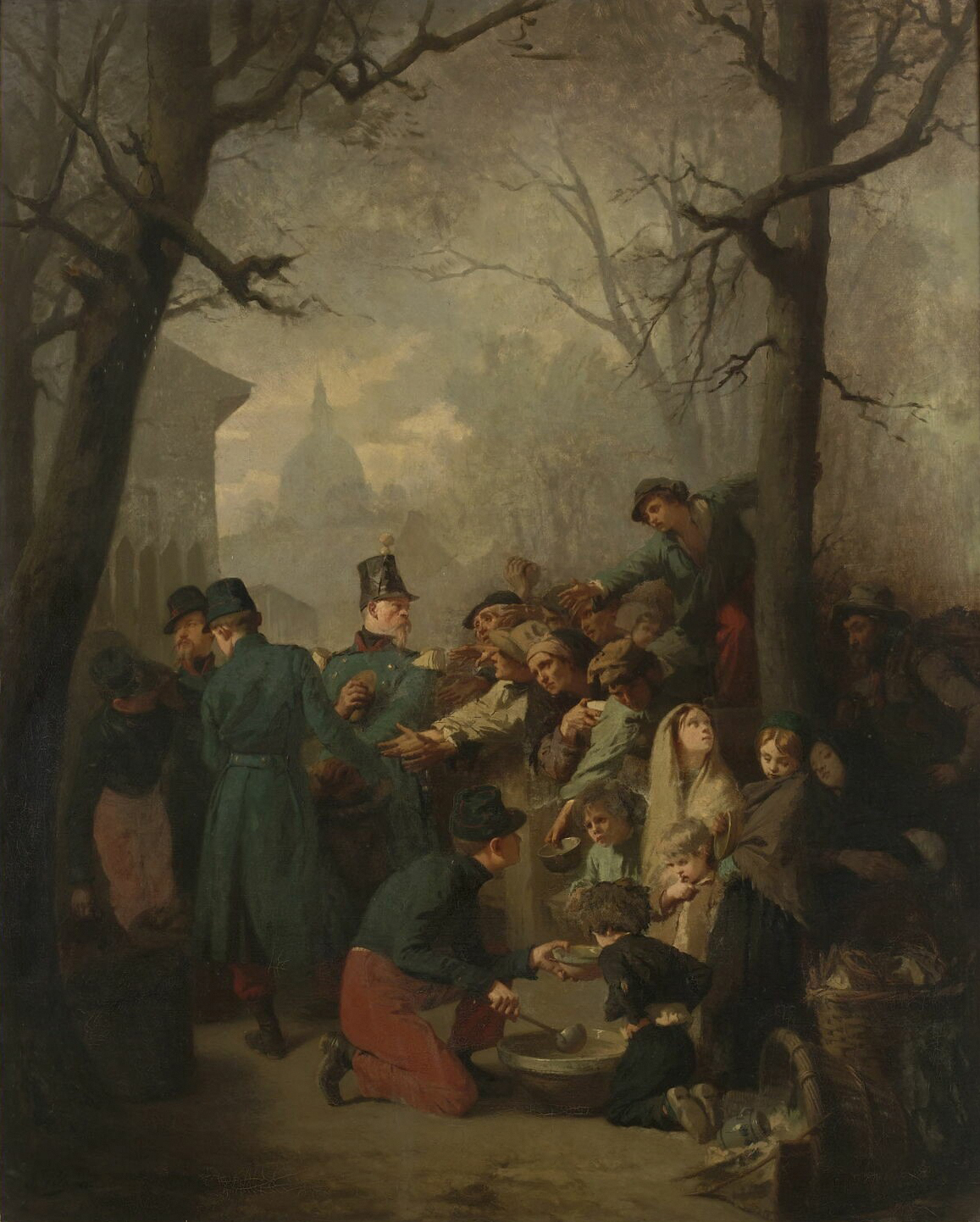
Other drawings relate to two significant realist paintings. During preparations for Soldiers Distributing Bread to the Poor (1852), Isidore Pils used red chalk to work out the poses and lighting of a mother and child awaiting food during a famine in Paris (figs. 18–19). In the painting—based on a scene Pils saw—the woman stands with a bowl in her hand, next to a boy with outstretched arms; the child’s head is just above her at the right. Two preliminary drawings for the enormous mural Mystical Brittany by Hippolyte Berteaux glorify the Breton celebration of faith called a Pardon. The larger, more forceful sheet shows a man in traditional Breton costume—complete with wooden shoes—solemnly parading while flanked by serious-looking altar boys (cat. no. 20). Today, the mural is badly damaged and lies in the storerooms of the Nantes art museum, making the Weisberg drawings important to our understanding of the work.
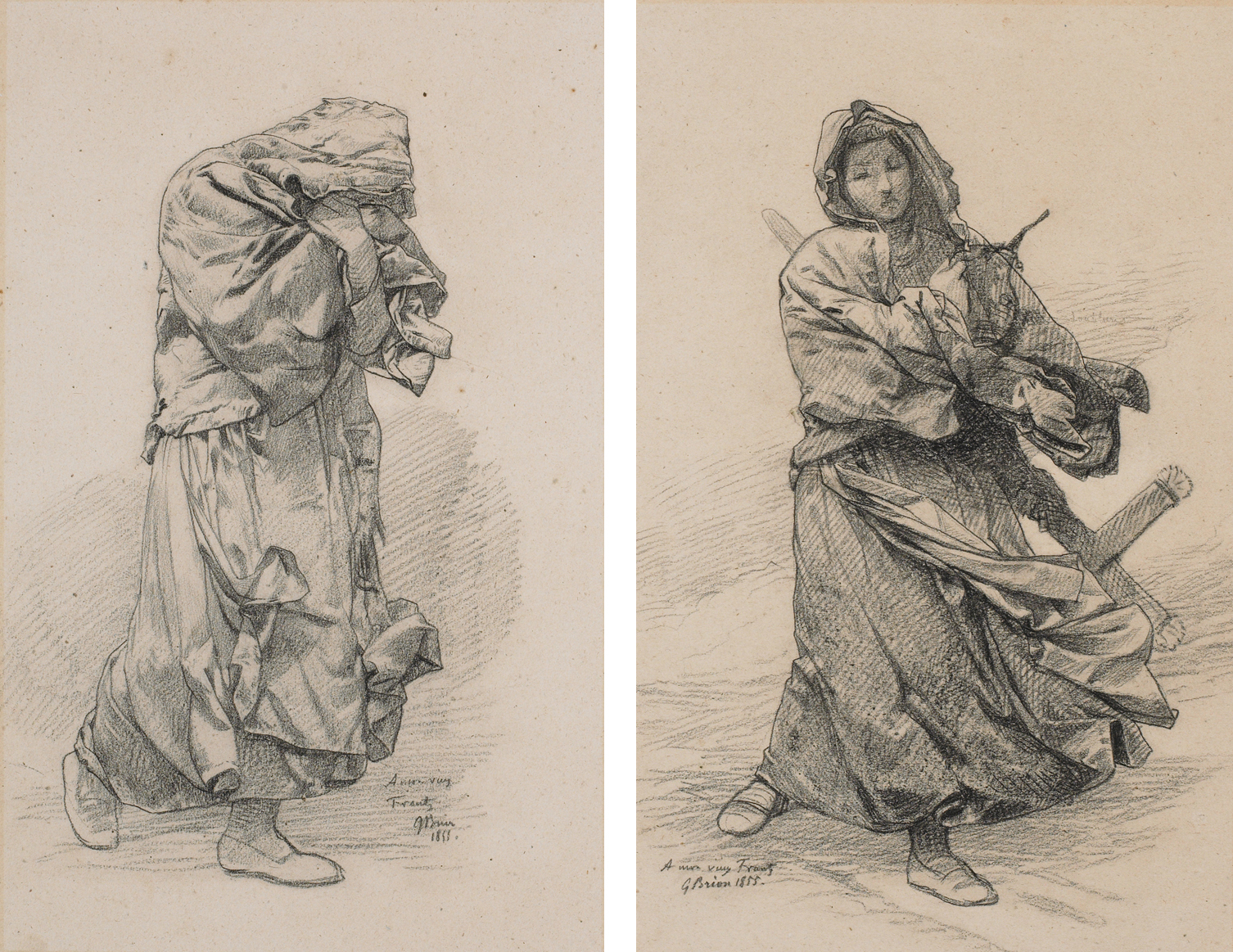
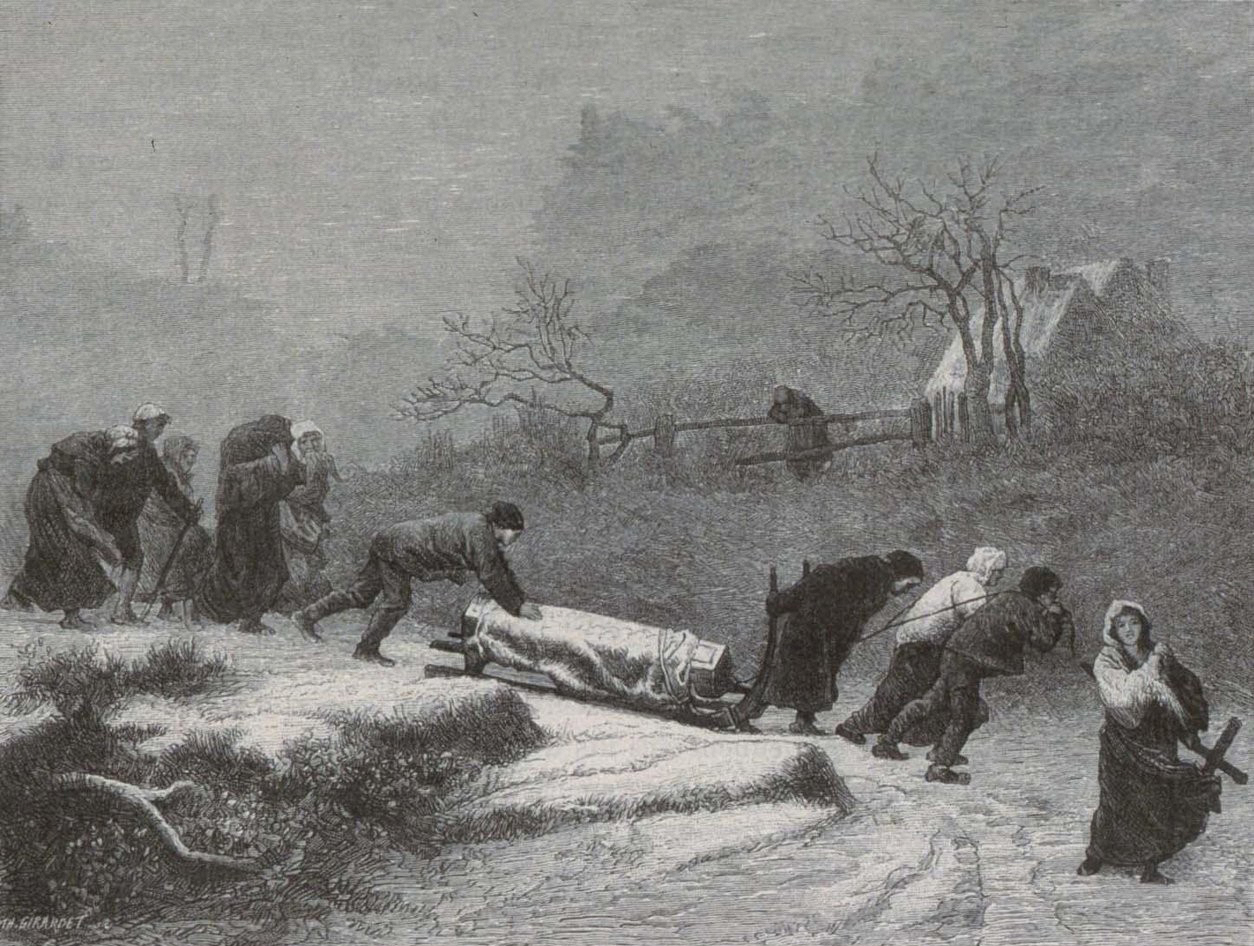
There are several preparatory studies for single figures beyond Breton’s gleaner. Two by Gustave Brion show women on the way to a burial in Vosges, a hilly region of northeastern France (fig. 20). The final painting was shown at the Paris Exposition Universelle (World’s Fair) of 1855, but it is now lost and known primarily through lackluster engravings. The lively drapery in the drawings reveals the high quality of Brion’s work, but this is completely lost in at least one print (fig. 21). While working on a large painting of a civil marriage ceremony for a local city hall in Paris, Henri Gervex meticulously studied the court clerk, going so far as to test out an alternate position for the man’s left hand (cat. no. 75). As a young man, Bernard Boutet de Monvel made numerous studies of a woman known as Mère Caillot (Mother Caillot), who sold meat from a market stall in the medieval French town of Nemours (cat. no. 34). From these sprang a series of paintings, watercolors, and prints featuring this fixture of village life. Such assiduous practice led Boutet de Monvel to a glamorous career as a society portraitist.
Sometimes preparatory drawings make sense only when seen in the context of the finished artwork. At first glance, Jean Béraud’s man in a knee-length coat, its pocket stuffed with papers, seems to be a doctor, professor, or some other eminence (fig. 25). But in the completed painting, now lost but known through reproductive prints, he is observing patients in a Parisian psychiatric asylum—and may be a patient himself. Similarly, the curved black lines above the woman’s head in Henri Bouvet’s study (cat. no. 38) seem out of place until we know that Bouvet planned to insert the figure into an intimate gathering illuminated by a constricted pool of lamplight.
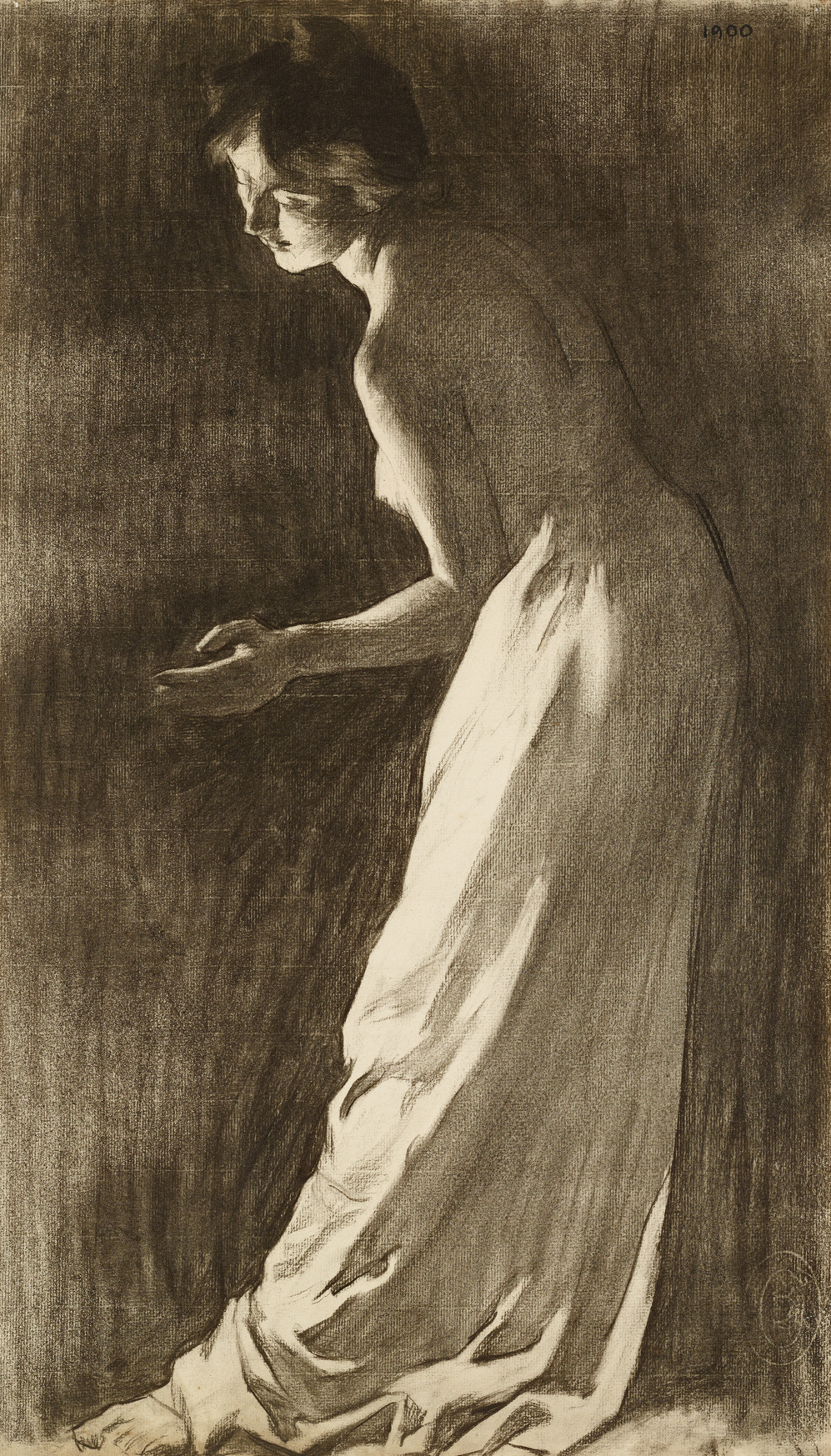
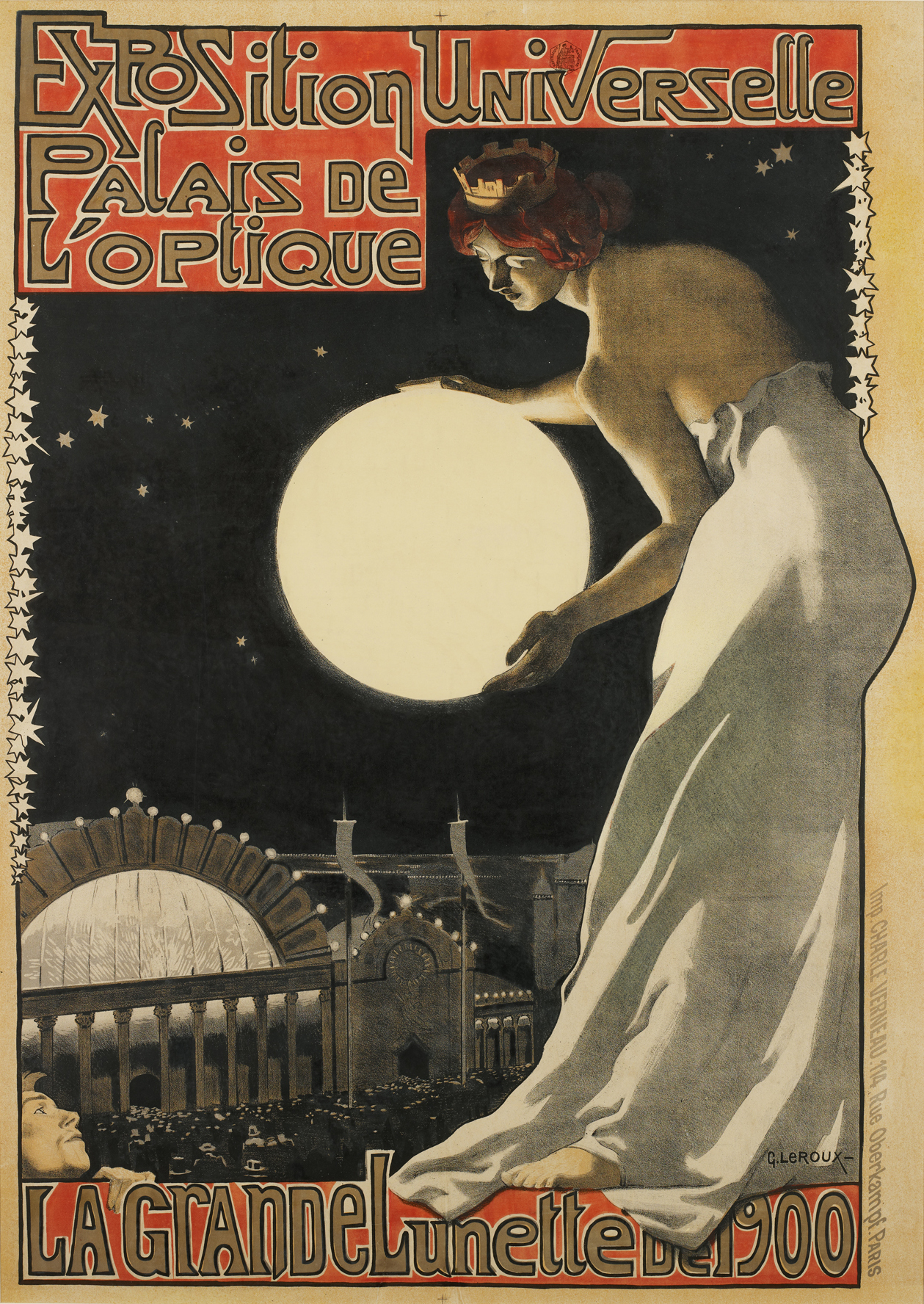
Prints are helpful not just for reconstructing lost paintings. They can also disseminate an artist’s work to collectors and the broader public. Such was the case with Xavier Mellery’s image of a woman studying her Bible with a cup of coffee or tea close at hand (cat. no. 124). Studying Mellery’s complex combination of charcoal, ink, chalk, and thinned oil paint, printmaker Joseph Antoine Dujardin translated the drawing into an etching. Having a composition broadcast this way proved an important early step in establishing Mellery’s name and career. Julien Celos used his brooding night scene, The Dead City, Bruges (cat. no. 47) as the basis for a color etching. In the process, he transformed the image, making it brighter, more colorful, and less forbidding.
Other drawings ended up in the mass market as posters or magazine illustrations. Georges Paul Leroux’s study of a half-clothed, dramatically lit woman is preparatory to the main figure on a big Art Nouveau poster that Leroux designed to advertise an attraction at the Paris Exposition Universelle of 1900 (figs. 22–23). The Weisberg Collection includes the marvelous poster in extraordinarily fresh condition.
By the late nineteenth century, magazine publishers had the ability to transfer drawings to printing matrices by photographic means. Thus, the Parisian periodical Gil Blas Illustré was able to use a colorized version of Louis Legrand’s drawing of a cabin boy in the arms of a prostitute (cat. no. 103) as a cover illustration in December 1891. Inside, audiences could read the story about the lonely boy’s fleeting friendship in a brothel. The journal L’Assiette au Beurre devoted an entire issue in 1903 to Aristide Delannoy’s drawings examining the lives of the haves and the have-nots in the coal-mining region of southern Belgium and northern France. The Weisberg Collection has the drawing of barge haulers that appeared on a double-page spread (fig. 1, cat. no. 65).
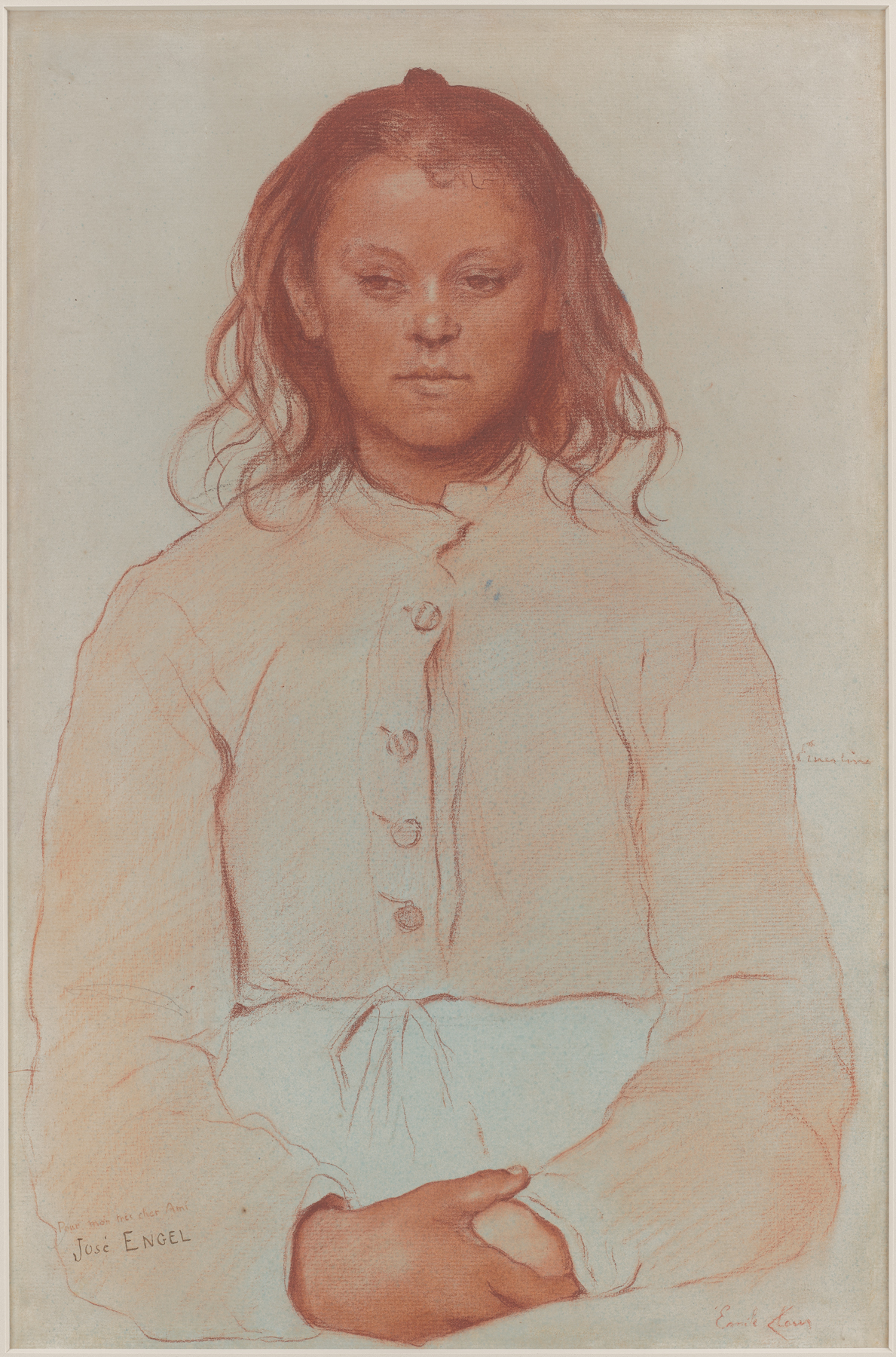
The middle-class audience that might read the Parisian weeklies was the main market for the realists. Though artists here sometimes won major commissions or sold big Salon paintings, most realists were not selling their humble subject matter to rich aristocrats, bankers, and industrialists. Their buyers were educated members of the professional classes—doctors, lawyers, architects, government officials—people interested in avant-garde art but unable to afford large paintings.2 This was the audience for the finished drawings, watercolors, and occasional small painting of, for example, the peasant girl in Emile Claus’s portrait Ernestine (fig. 24), the contemplative tanner by Lucien Ott, and the complex emotions of later life on view in Louis Welden Hawkins’s Peasant Woman in a Landscape (c. 1880), Bernard Boutet de Monvel’s Portrait of an Old Woman Seated in Front of a Door (1897), and Georges Scott’s Old Breton Woman in a Café (1906) (cat. no. 152, cat. no. 83, cat. no. 33, cat. no. 171).
Impact on Mia’s Collection
For its varied subjects, functions, and styles, the Weisberg Collection is remarkably cohesive. Even an outlier such as jeweler Henri Vever’s tender portrait of his newborn daughter (cat. no. 183) does not seem out of place, for its simple humanity and obvious skill are allied with the transcendent properties of so many other drawings in the collection.
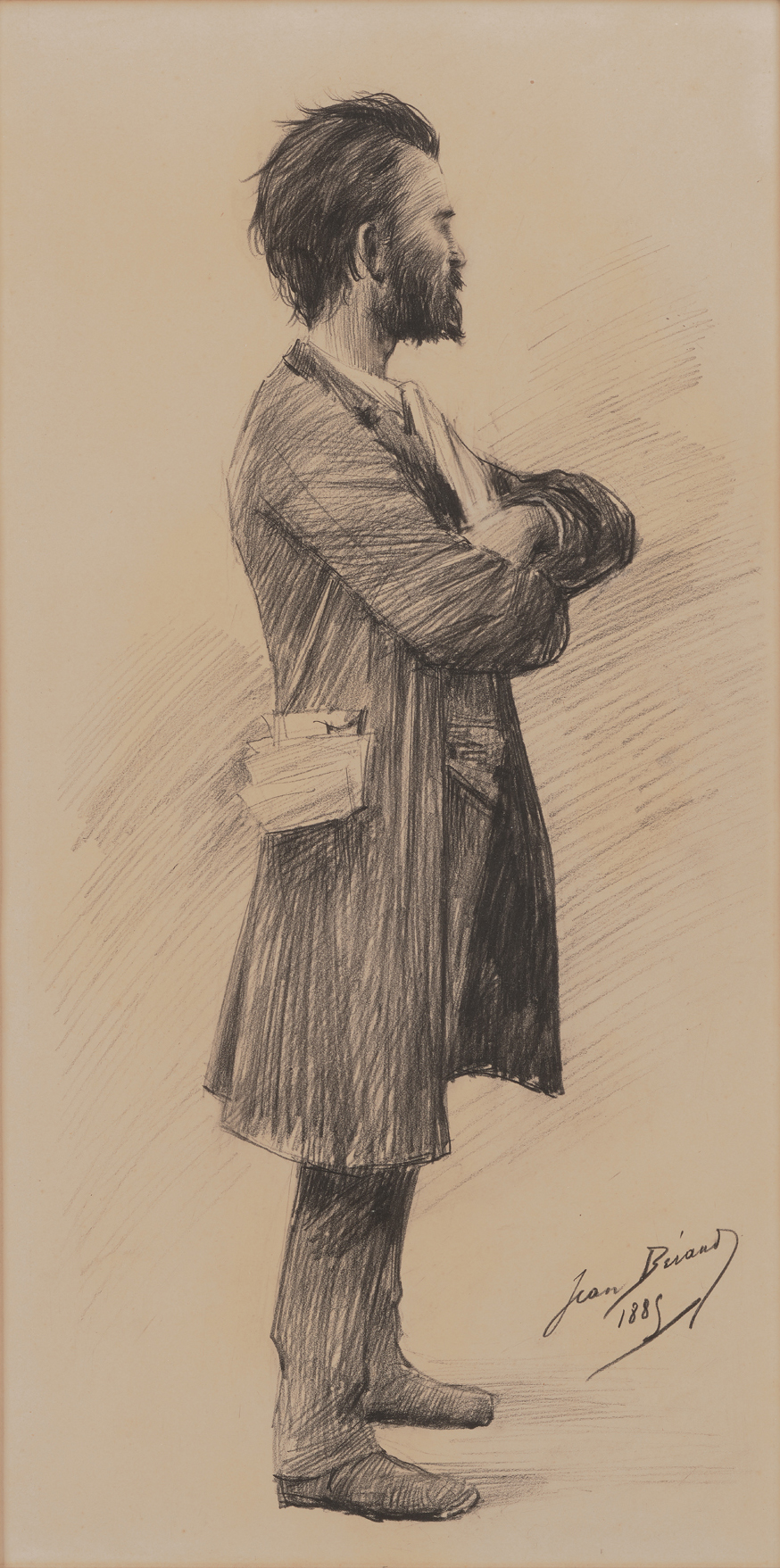
The entire Weisberg Collection will transform Mia’s collections of French and Belgian drawings, watercolors, and small paintings from 1830 to 1930. It will add more than sixty artists not otherwise represented in the museum’s collection. Most significantly, where Mia had nothing by Milcendeau, it will have a distinguished array of fourteen drawings and watercolors.3 In other instances, where Mia has had modest representation, it will eventually have gems. Here one thinks of artists such as Claude Joseph Bail, Béraud (fig. 25), Louise Breslau, Jules Breton, Pascal Adolphe-Jean Dagnan-Bouveret, Charles Jouas, Laermans, Albert Maignan, and Antoine Vollon.
Then there are the cases in which the Weisberg works will improve the holdings of artists already in Mia’s collection. These include the enviable cluster of Bonvin drawings and the already-donated painting (previously, Mia had just one drawing and five prints), and the four fine drawings by Lhermitte (joining Mia’s sole drawing and a print). In other cases, the Weisbergs’ generosity will add a capstone object that is destined to become Mia’s best example of an artist’s work. Such objects include Albert Besnard’s portrait of Jules Lafrance, two drawings of Parisian life by Edgar Chahine, François-Nicolas Chifflart’s dramatic scene of Queen Zenobia, Paul-Émile Colin’s design possibly for a deluxe book (fig. 26), Adrien de Witte’s allegory of Christian charity, Lalanne’s charcoal landscapes, Legrand’s nude, François Maréchal’s miner, Pils’s studies of a woman and child, and on it goes!
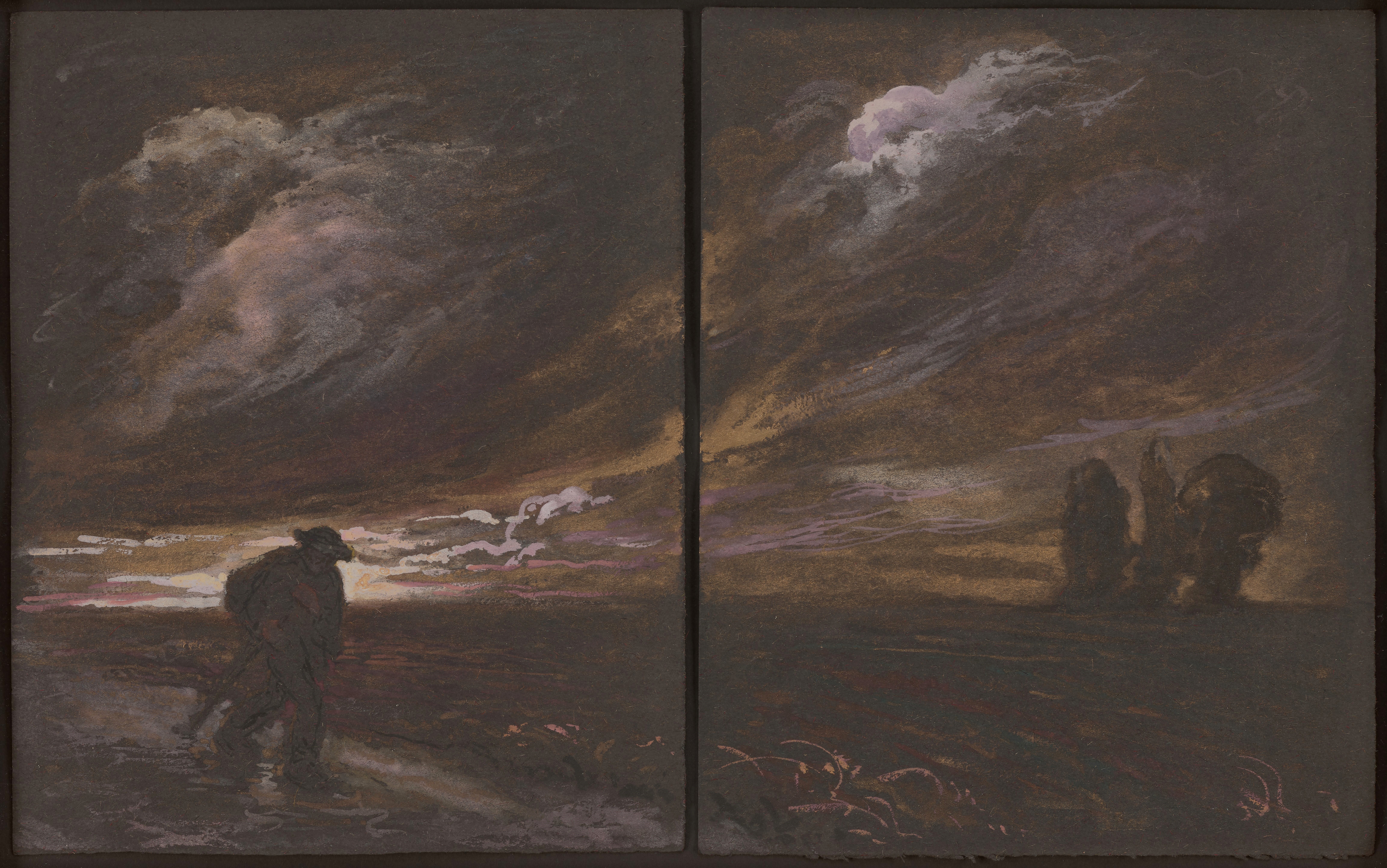
Finally, some of the Weisbergs’ holdings will deepen Mia’s already fine representations of certain artists; for example, enlarging Mia’s group of landscapes by Appian, adding remarkably early drawings to our works by Decamps and Jules Dupré, and adding fine drawings to our extensive collections of prints and drawings by Alphonse Legros and Auguste Lepère.
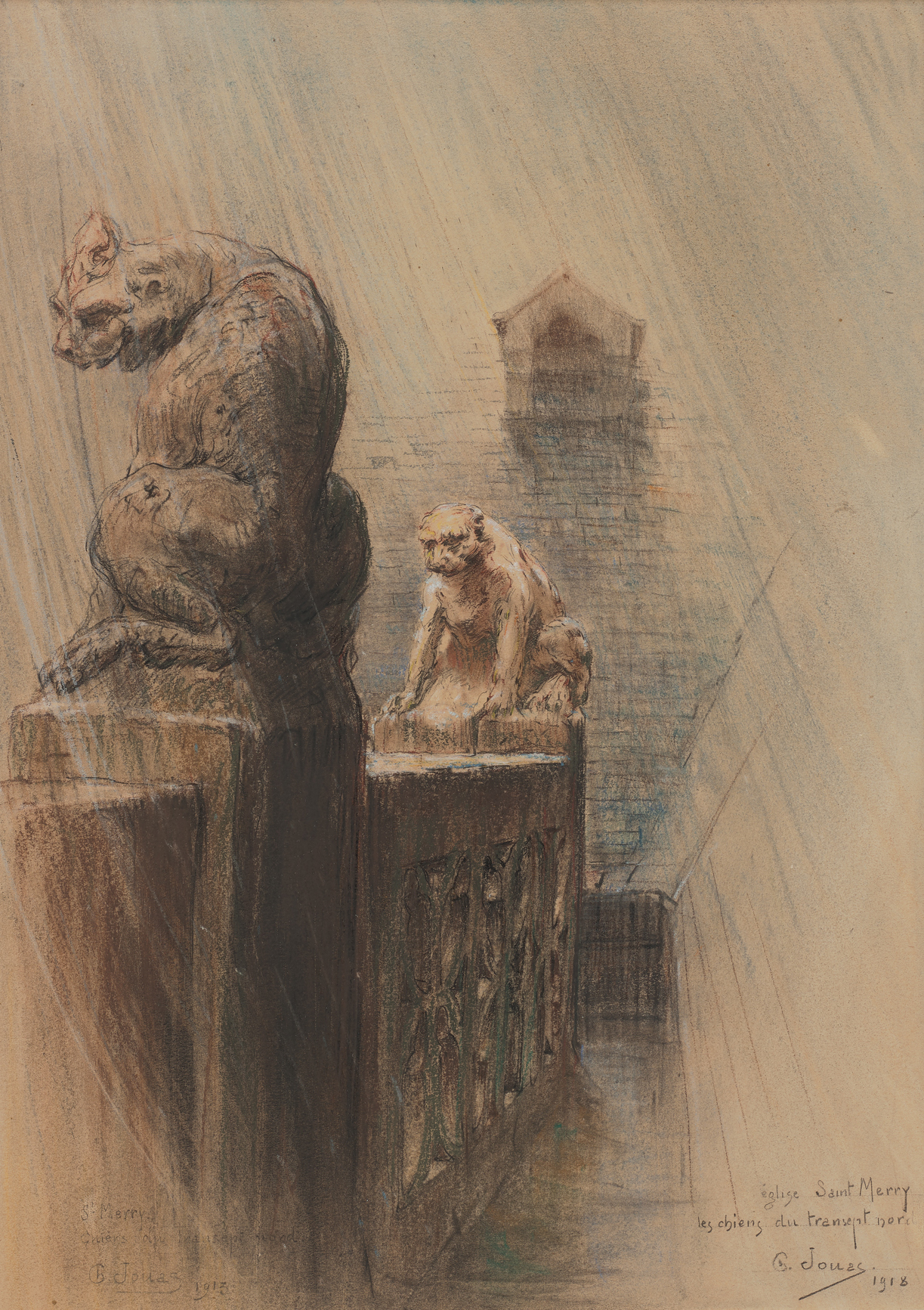
Though Realism takes center stage in the Weisberg Collection, one can also find traces of the Weisbergs’ other areas of expertise. Chifflart’s highly academic Zenobia (cat. no. 53) exemplifies much that the realists rejected. Nocturnal cityscapes by Ernest-André Andreas and Celos and gargoyles by Jouas embody the heightened emotions and mysticism of Symbolism (fig. 27).
Representing Naturalism is Dagnan-Bouveret, who in his pursuit of exactitude openly used photography in the development of his paintings (cat. no. 61). (His study of a costumed woman at a Breton Pardon was not taken from an actual ceremony, but rather from photos he took of models he recruited to pose for him.) The outré side of the Belle Époque can be seen in the nudes by Legrand and Rupert Carabin; Georges d’Espagnat’s portrait of chanteuse Yvette Guilbert provides a bit of respite from realist sobriety (cat. no. 104, cat. no. 45, cat. no. 60). Leroux’s nighttime view of a busy Paris intersection and Edouard-Louis Henry-Baudot’s industrial landscape of the city of Douai act as modernist codas to the collection.
The Weisberg Collection will help visitors discover countless new stories and make connections with artists in Mia’s encyclopedic collection. Etchings and paintings by old masters such as Rembrandt and Pieter de Hooch will resonate with the work of Bonvin and Jakob Smits. The art of Jean-François Millet can be seen in the works by Breton, Léon Frédéric, Hawkins, Milcendeau, and others who took an interest in rural life. Legrand will hold his own when matched with other brothel creepers such as Toulouse-Lautrec and Degas. Religious processions in the Weisberg Collection—especially in the form of the Breton Pardon—will find parallels in art from Germany to Mexico to China. American Regionalism, most famously the work of Thomas Hart Benton and Grant Wood, may look unlike the work of the realists, but artists on both sides of the Atlantic shared a desire to give visual expression to regional traditions (think of Berteaux’s Brittany, Milcendeau’s Vendée, and Delannoy’s coal-mining district). Some visitors will detect a kinship between these realist drawings and the photographs of British contemporaries such as Peter Henry Emerson or the Depression-era photographs of Walker Evans and Dorothea Lange. In the coming years, many such slices into the collections will be investigated in Mia’s study rooms. Some could result in new exhibition ideas.
The Weisbergs are educators. Their profound generosity will provide present and future generations untold opportunities to learn. These artworks will make it possible to go beyond the textbook accounts of nineteenth-century French and Belgian art—the former usually focused on big-name artists who often did not typify contemporary cultural norms, the latter generally skipped over entirely. When the Weisberg Collection is fully integrated into the museum’s collection, Mia will be one of the foremost resources for Realism in the United States.
Despite our temporal distance from the nineteenth century, the ideas behind realist art remain relevant today. Every generation experiences an upending of its life and expectations. The powerful still roll over those less fortunate; people still find themselves without shelter, a livelihood, or options. Issues of displacement, isolation, employment, inequity, and communal cohesion were present then and remain with us now. Just as today’s ubiquity of cameras has borne witness to social wrongs, the realists broke away from the conventions of academic art to bear witness to ignored citizens. Although these artists could not post their observations instantly to their followers, many managed to place their images in exhibitions or get them reproduced in books, magazines, and prints. Now, in the early 2020s, works by many of Realism’s most ardent proponents are being exhibited again, and their often-unsung efforts can be viewed all over the world by means of this online publication.
Notes
Gabriel P. Weisberg, Bonvin, trans. André Watteau (Paris: Éditions Geoffroy-Dechaume, 1979). Prior to this, the artist and collector Etienne Moreau-Nelaton had published his own book on Bonvin, Bonvin raconté par lui-même (Paris: Henri Laurens Éditeur, 1927). ↩︎
Petra ten-Doesschate Chu, “Into the Modern Era: The Evolution of Realist and Naturalist Drawing,” in The Realist Tradition: French Painting and Drawing 1830–1900 (exh. cat.), by Gabriel P. Weisberg, Cleveland Museum of Art and other venues (Cleveland, 1980), p. 36. ↩︎
Other artists not previously represented in Mia’s collection but present in the Weisbergs’ in more than one example include: Jules Adler, Hippolyte Berteaux, Bernard Boutet de Monvel (and his father, Louis Maurice), Gustave Brion, Charles Cottet, Georges Paul Leroux, Xavier Mellery, Constantin Meunier, Simon Moulijn, Lucien Ott, and Alexis Vollon. ↩︎